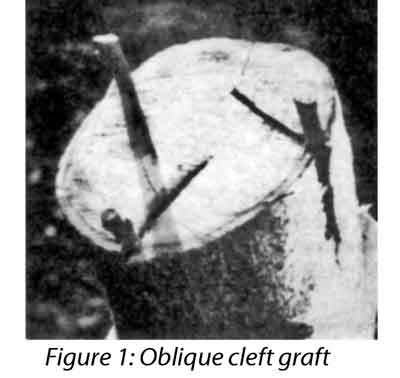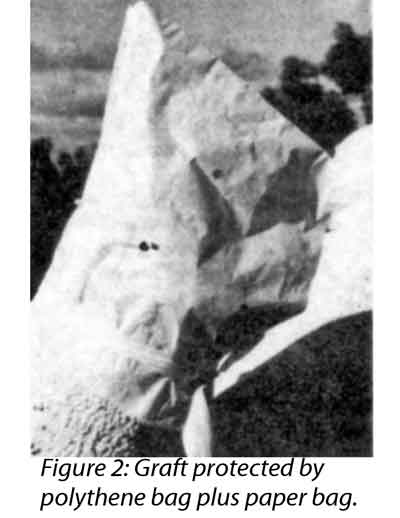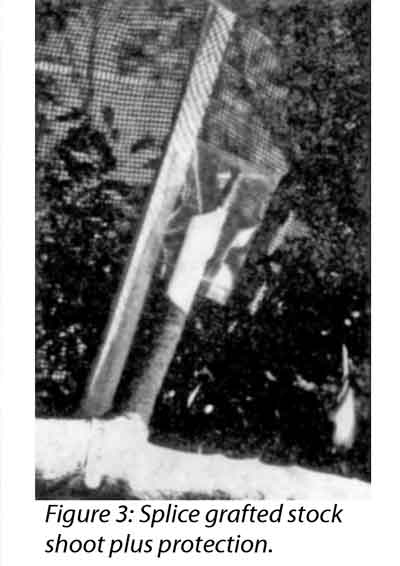
TOPWORKING AVOCADO TREES
SCIENTIFIC NAME: Persea americana
FAMILY: Lauraceae
Procedures are described for topworking avocado trees in order to change varieties or to limit the tree size as an alternative to tree thinning. Success can be achieved by pruning and grafting at the optimum time by the chosen method and by providing sufficient protection and aftercare to avoid losses from desiccation, sunburn, temperature extremes or high winds.
Introduction:
Topworking is an old established technique for changing varieties in fruit trees, in which the tree is pruned back to short branch stumps, then grafted over to the desired variety. Scions are placed either directly into the stumps or into the shoots which soon sprout from the stumps.
This is a useful technique in a number of other situations. Seedling trees can also be worked over to improved varieties. Trees on which the scion portion has died and the stock has regrown strongly can be regrafted. Overcrowded orchards may be thinned by topworking alternate trees instead of removing them (Lee 1973) then later topworking the remaining trees, before finally resorting to tree removal. The great advantage of topworking is the rapid regrowth of the tree to a size capable of sustaining high yields. A topworked tree can reach a production level after two years, which would take a newly-planted tree from 4 to 6 years to attain.
This paper outlines some of the standard techniques of topworking and details are given of additional measures necessary for success with avocado trees.
THE TECHNIQUE
1. Choosing the most suitable time.
Grafting should be timed so that the stock and scion are in optimum condition and will unite rapidly. Also, the weather conditions expected after grafting should be suitable for the survival of the scion.
These conditions usually occur in spring and autumn when diurnal temperatures fluctuate between minima of above 10°C and maxima of 25 to 30°C. Early spring is preferred because the carbohydrate levels of both stocks and scions are at their highest (Scholefield 1979). In winter, lower temperatures slow callus formation and there is always the chance of the death of a scion due to frost. High summer temperatures can cause death of even well-protected scions, especially before they have started to grow.
2. Preparation of rootstock.
Trees chosen for topworking should be showing satisfactory growth and health. The major branches are pruned to stumps at a convenient working height. Pruning cuts are made so that none are horizontal and the cut surfaces will thus shed water and bleeding sap to reduce the risk of fungal infections. Healing is speeded by making clean pruning cuts as near as possible to perpendicular to the limb's axis.
If available, a few small branches near the base of the tree are left unpruned to provide a sap flow in the trunk and to maintain the roots in good health. The sap flow in the trunk may assist in cooling the stump in hot weather (Garner 1958). These 'nurse' branches appear not to be necessary on avocados where summer temperatures are not excessive (Platt and Frolich 1965; Ruehle 1958).
Branches exposed to the sun must be protected from sunburn by shading or by painting with a white water-based paint.
3. Selection of scion wood.
The best time for collecting graftwood is late winter to early spring, just prior to the spring growth flush. At this time, carbohydrate reserves in shoots are near their peak.
Scions should be taken from parent trees of known superior performance and good health. Trees registered with the Australian Avocado Growers' Federation as free from sun blotch virus are ideal.
For top working graftwood, thicker, well-matured shoots of up to 2 cm diameter are selected. The terminal growth is often discarded as being too 'soft' for field grafting. The rest of the shoot is deleafed if necessary and cut into pieces 5 to 10 cm long, each piece bearing several plump, well-developed buds. This wood may be stored for up to 3 months in a sealed plastic bag in a domestic refrigerator.
4. Grafting.
Grafting may be performed in early spring by either the bark, oblique cleft, or saw kerf techniques, with freshly-cut scion wood grafted into recently-pruned stock branches. Alternatively, it may be done by the splice, whip and tongue, wedge or oblique wedge techniques into shoots which arise from the stumps 2 or 3 months after they have been pruned.
The former grafting time has the advantage of a longer growing season for the scion. The main disadvantage is the more difficult sorts of graft employed.
Grafting into young side shoots from the cut stumps is easier, but repeated checking is needed to prevent new grafts being overgrown and shaded out by other side shoots. Scion wood must either be stored from later winter - early spring or can be freshly cut, but then has the disadvantage of lower carbohydrate reserves.
A proper grafting or budding knife is most useful for this work. Any knife used for grafting must be kept razor sharp and should be cleaned between grafts as necessary.
When making grafting cuts, the knife is drawn through the wood with a slicing action, preferably in one smooth continuous stroke. If necessary, the cut surface is pared to ensure flatness.

Bark or rind grafts
Such grafts may be used in spring or summer when the bark is readily lifted from the wood. The stock is prepared before the scion, first recutting the stump if necessary, back to healthy live wood.
A position on the stock with maximum flatness and evenness of the bark-wood junction is chosen for the graft. A cut is made through the bark to the wood, starting at the freshly-pruned end and extending about 5 cm along the axis of the stump. The bark on either side of the cut is then carefully levered away from the wood, taking particular care not to scrape or rub the cambium layer on the wood surface. When the stock is ready, the scion is prepared by making a long oblique cut from one side to the other. To make scion insertion easier, the thin flexible base, or tail, is removed by a short cut from the opposite side. The scion is immediately pushed down between the lifted bark and wood with the long, cut surface towards the wood. Several scions may be inserted around a stump in this way.
Variations of this technique are to lift the bark only on one side of the vertical cut or to make two vertical cuts, then peel back the bark between them. If the bark of the stock is too thick for easy working it may be pared down to about 5 mm thick. As soon as the scions are in place they are secured by wrapping the end of the branch with PVC budding tape or flagging tape. We have found the latter, being heavier and wider, provides greater tension and covers the grafts more quickly.
Oblique cleft grafting (Figure 1).
This may be successfully performed even when the bark will not readily separate from the wood. The end of the stock stump is cleft or split along its axis using a cleaving tool and mallet similar to that described by Garner (1958). Clefts are made to about one-third of the stump diameter and directed to one side of the centre of the stump. Depending on the diameter of the stump, one or several grafts may be made. The clefts are held open in turn with the end of the cleaving tool to receive a suitably-shaped scion. Each scion is shaped by two oblique cuts from opposite sides to a long thin wedge which is thicker
on the side intended to face the outside of the cleft. It is inserted so that the cambia of the stock and scion coincide as far as possible, then the cleaving tool is released from the cleft. Binding of these grafts is unnecessary as they are held in place by the resilience of the cleft stock.

The voids remaining in the cleft stump can be plugged with clay or a grafting compound, although we have found the latter is inclined to melt and flow into the graft union area under very high temperatures. The completed graft is then protected using a polythene bag followed by a paper bag tied over the end of the stump.
Saw kerf or notch grafting.
This graft requires considerable skill and experience for success. A saw cut is made in the cut stump extending down one side for 10 to 15 cm and about 3 to 5 cm deep. The cut is then widened into a notch which tapers both towards the inside and the bottom using a tool such as a broad chisel or sharpened putty knife. The width of the notch is made to match the expected size of the scion.
The scion is cut to a long wedge thicker at one side than the other (as for the oblique cleft graft). The lower part of the thinner side is then cut off to facilitate insertion into the stock. When the notch in the stock and the scion are a good match the scion is tapped into place. If the corners of the bark of the notch are bevelled the cambium of the stock is visible to aid in the correct positioning of the scion. A well-cut scion does not require binding, but should be protected as for a cleft graft.
Grafting onto shoots arising from pruned stumps.
A profusion of vigorous shoots develops by mid-spring on stumps pruned in late winter. If grafting by the methods outlined in (a), (b) or (c) above have been successful, the sideshoots should be removed or thinned and pruned to provide some shelter for the developing grafts. If the earlier grafting was unsuccessful, 2 or 3 suitably-placed regrowth shoots on each stump can be re-grafted. The remainder can be thinned and pruned to provide shelter. Stock shoots with the same diameter as scion graftwood may be grafted with a splice, whip and tongue or wedge graft as has been reported for seedlings (Anon. 1982).
If stock shoots are much thicker than the available scion wood, the most convenient graft is a type of simple splice graft. The shortened stock shoot is prepared by cutting a shallow slice from one side, starting about 3 cm below and extending to the top of the shoot. The scion is cut as for a long splice graft so that the line of cambium most nearly matches that of the stock. The stock and scion are then bound together using grafting or flagging tape. The scion may be protected by wrapping with tape (finger bandage style) or by a polythene and paper bag (Figures 2 and 3).

5. Protection of grafts.
Under Murray Valley conditions, it is essential to protect new grafts from sunburn, excessive winds or temperature extremes and desiccation. In the more humid avocado growing areas, protection from drying is less important (Chalker 1974; Ruehle 1958).
We have found that covering the grafted branch stump with a suitably-sized polythene bag plus a ventilated white paper bag has provided satisfactory protection (Figure 2). Grafts covered with a polythene bag only or with a polythene bag and a brown paper bag were liable to damage from sunburn unless further protected by shade cloth. Shadecloth attached to light timber lathes nailed to the branch stump provided satisfactory cover where it was well anchored against wind (Figure 3).
Commercial grafting sealants have proved unsuitable where high summer temperatures prevail. Black-coloured preparations tend to overheat and waxes tend to melt into the graft. Garner has suggested a pug of clay for filling the voids created in cleft grafting (Garner and Chaudhri 1976). Painting exposed shoots with white water-based paints is a satisfactory method of sunburn protection.
Some protection from wind and sun can be obtained from unpruned side shoots. However it is essential that these never overshadow and dominate the new grafts. Repeated inspection and pinching of shoot tips is necessary.
6. Aftercare of grafts.
Grafts should be inspected 6 to 8 weeks after grafting and unwrapped or uncovered as necessary. The progress of grafts inside a polythene plus paper bag combination may be inspected through a vertical slit cut in the paper bag. As the scion grows, both bags are slit open but left in place until the new shoots provide their own leafy shade.
New scion shoots are protected from damage due to wind by tying them to conveniently placed stock shoots or to timber lathes nailed to the stock.
Side shoots other than grafts are suppressed initially by pruning their tips and finally by complete removal. Newly exposed shoots or branches may be protected from sunburn by painting with white water-based paint.
References
Anon. (1982). The making of an avocado tree. Avocado Grower, 6 (2): 32-3.
Chalker, F. (1974). Reworking avocado trees. N.S.W. Dept. of Ag. Bul. H6.3.5.
Garner, R.J. (1958). The Grafter's Handbook, 2nd Ed. (Faber and Faber Ltd.: London).
Garner, R.J. and Chaudhri, S.A. (1976). The Propagation of Tropical Fruit Trees, (Commonwealth Agricultural Bureaux: Slough).
Lee, B. W. (1973). A planting plan for a new grove, Citrograph, 58: 333-4.
Platt, R.G, and Frolich, E.F. (1965). Propagation of Avocados. Cal. Agric. Exp. Sta. Ext. Serv. Circ. 531.
Ruehle, G.D. (1958), The Florida avocado industry. Fla. Agric. Exp. Sta. Bul. 602.
Scholefield, P.B. (1979). In CSIRO Div. Hort. Res. Report 1977-79.
Bill Lewis is a Senior Technical Officer with the C.S.l.R.O. Division of Horticultural Research at Merbein, Victoria. He has been involved with the propagation of avocados, mangos, citrus and other tropical and sub tropical crops for the past six years.
Mr. D. McE. Alexander joined CSIRO Division of Horticultural Research in 1948 after gaining a B.Sc. at Melbourne University. He obtained a M.S. from the University of California, Riverside, in 1966. He is now leader of the tree research group of the Division and is involved wi1h research into temperature and tropical tree fruit and nut species, with particular emphasis on pistachios, mangoes and annonas.
DATE: January 1983
* * * * * * * * * * * * *
